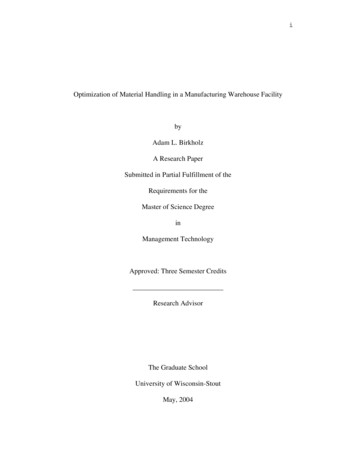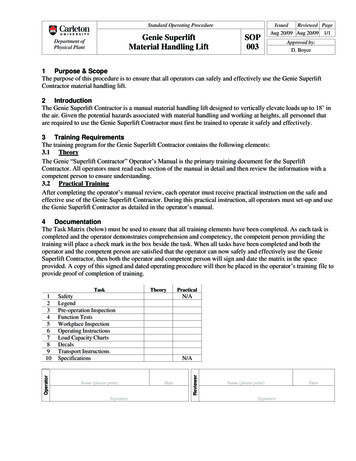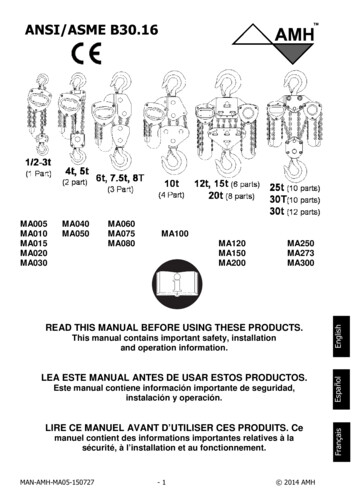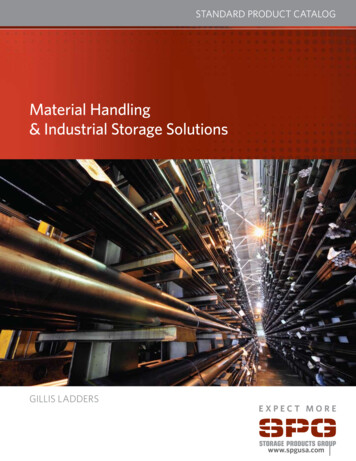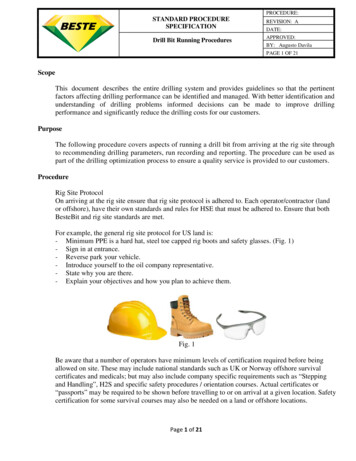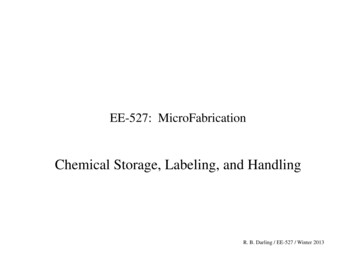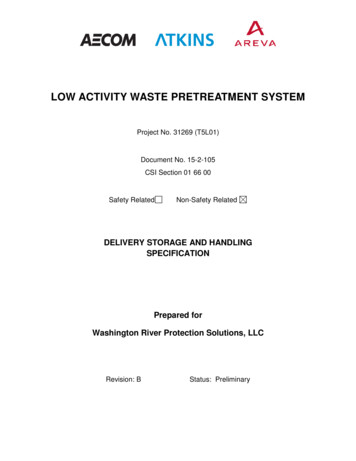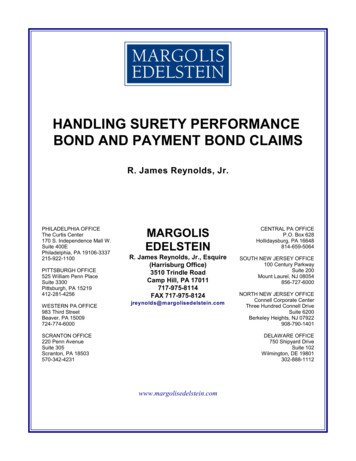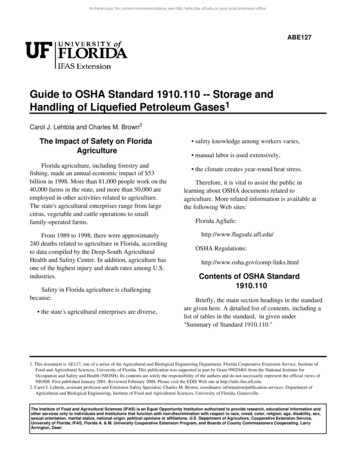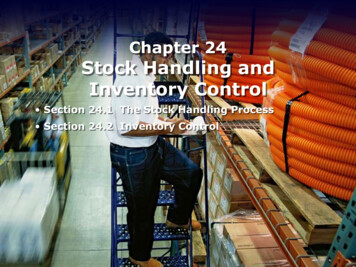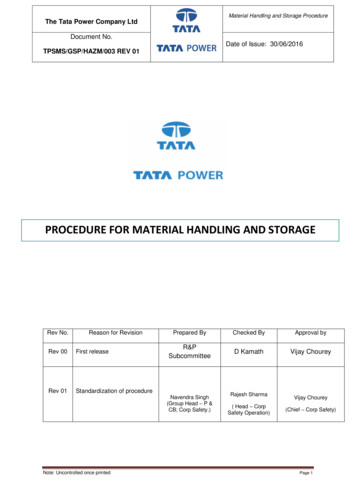
Transcription
Material Handling and Storage ProcedureThe Tata Power Company LtdDocument No.Date of Issue: 30/06/2016TPSMS/GSP/HAZM/003 REV 01PROCEDURE FOR MATERIAL HANDLING AND STORAGERev No.Reason for RevisionRev 00First releaseRev 01Standardization of procedurePrepared ByChecked ByApproval byR&PSubcommitteeD KamathVijay ChoureyNavendra Singh(Group Head – P &CB; Corp Safety.)Note: Uncontrolled once printedRajesh Sharma( Head – CorpSafety Operation)Vijay Chourey(Chief – Corp Safety)Page 1
Material Handling and Storage ProcedureThe Tata Power Company LtdDocument No.Date of Issue: 30/06/2016TPSMS/GSP/HAZM/003 REV S2.1Station head2.2Competent Authorised Person2.3SupervisorsPERSONNEL3.1Specialists (personnel certified to carry out the work)INSPECTION AND CERTIFICATIONHAND TRUCKSFORK LIFT TRUCKS6.1Operations6.2Parking6.3Operating Areas6.4Attachments6.5General Operations6.6Rough TerrainCRANESSIGNALSGENERAL PRECAUTIONSLIFTING ACCESSORIES10.1Chains10.2Fibre Slings10.3Wire Rope and Wire Rope Slings10.4Sling Angles10.5Wire Rope Clips10.6Shackles10.7Plate Clamps10.8Eyebolts10.9Hooks10.10 Chain Blocks10.11 Load BindersLOAD SECURITYMATERIAL STACKING AND ON STRAPPINGCONTAINERSMANUAL LIFTING TECHNIQUESCRANE SAFETY CHECKLISTSINSTALLATION OF WIRE ROPE CLIPS OR DOUBLE SADDLE CLIPSRISK CONTROLSREFERENCESNote: Uncontrolled once printedPage 2
Material Handling and Storage ProcedureThe Tata Power Company LtdDocument No.Date of Issue: 30/06/2016TPSMS/GSP/HAZM/003 REV 011 INTRODUCTION1.1 PurposeThe purpose of this document is to provide procedures to assist the safe handling ofmaterials (manual handling and mechanical handling).1.2 ScopeThis document describes the requirements for the following –Responsibilities in materials handling.The requirements for specialist personnel.Lifting equipment requirements, ranging from a fork lift truck to a heavy lift mobilecrane to a simple eyebolt.The requirements for the safety of materials in transit and in store.This document does not override any other company regulations, international orlocal regulations.Regulations relating to lifting equipment.1.3 TerminologyAbbreviations terms and references used frequently in this document are defined in the TataPower Cos Procedure for material HandlingDefinitionBanks man: The person who is responsible for giving directions to a crane operatorAnti-two-blocking device - a device that, when activated, disengages all crane functionswhose movement can cause two-blocking.Competent person - one who is capable of identifying existing and predictabledeficiencies in mobile cranes and boom trucks.Emergency operations - operations that include fire, power line contact, loss of stability, orcontrol malfunction.Health-care professional - any licensed/registered/certified health-care providerworking within his or her license/registration/certification and providing medical servicesto employees. This includes physicians, physician assistants, nurse practitioners, andregistered nurses.Mobile crane - a crane that is self-propelled. This includes crawler cranes, wheel-mountedcranes, and any variations thereof. Overhead cranes, gantry cranes, side boom tractors,trolley boom cranes, and cranes with a rated capacity of one ton or less arespecifically excluded.Periodic inspection - detailed safety and maintenance inspection performed by aqualified person to verify compliance with the provisions of local/country standardsQualified person - one who, by possession of a recognized degree, certificate, orprofessional standing, or certified government body or who by extensive knowledge,training, and experience, has successfully demonstrated the ability to solve or resolveproblems relating to mobile cranes and boom trucks.Two-blocking - the condition in which the lower load block or hook assembly comesin contact with the upper load block or boom point sheave assembly. (Condition underNote: Uncontrolled once printedPage 3
Material Handling and Storage ProcedureThe Tata Power Company LtdDocument No.Date of Issue: 30/06/2016TPSMS/GSP/HAZM/003 REV 01which the load block or load suspended from the hook becomes jammed against thecrane structure preventing further winding up of the hoist drum)SWL - Safe working loadSLI – Safe load indicator, it is a system which cut-off all the unsafe crane operations ifoverloaded and anti two blocking comply.Safe access route to the place for the crane set up shall be checked with SS or SFE.Ensure that ground can carry the load of the crane. If soil is soaked with water the loadingcapability is significantly reduced. Check for underground cables and pipes as well as vicinityto any above ground obstructions like fire hydrants, firewater valves and pits. Ensure thattrailer bringing the load also has a safe access, not blocked by the intended set up of thecrane.Load: Weight of load can be from equipment data sheet, marking on packing, marking onpipe spool, calculation (add 15% allowance for inaccuracies) or weighing. Guessing theweight of the load is not allowed. Crane user shall maintain record of how the weight wasderived until the lift is successfully completed.Length x Width x Height (LxWxH): Is required for bigger equipment for deciding liftingradius and lifting height. For bigger surface, say above 25 m2, also wind loads need to beconsidered. For small pipe spools, valves etc. this data is not required.Lift Radius: Maximum horizontal distance between the point at which the centre of cranerotation meets the ground and the vertical centreline passing through the load liftingattachment.Lift Height: The height above the setting of the crane that the load must be lifted to. Toderive at the boom height the length of hook, slings and load must be added as well as somefree space above any equipment the load will be slew over.Eccentric Load: Load centre of gravity does not correspond to the geometrical centre, e.g.an unevenly loaded container. In case of eccentric load for heavy loads, say above 2 T,centre of gravity should be calculated and lifting points defined accordingly. For light loadsthe most practical is to determine the centre of gravity by trial and error without lifting theload completely off the ground.Ground for crane set up safe: Can the ground support the point load from outriggers orcrawlers? Ground loading capability must be established. Underground cables and pipesexposed to the load of the crane shall be identified and if required protected by spreadingthe load by e.g. applying spreaders under the outriggers. Experiences at site and elsewherehave shown that paved areas are not necessarily having the loading capability as perdesign.Safe workload at lift radius will be derived from the selected Crane Load Chart for thecalculated lift radius and boom length. Adjustment shall be done in relation to valid load testand only 90% of the load test value shall be considered as safe workload.Weight of hook block, slings and attachments shall be derived from crane load chart andtables for slings.Total weight is the sum of the weight of the load and weight of hook block, slings andattachment.Capacity loading will be calculated by dividing the total weight with the safe workload at liftradius. It shall not exceed 85%. For capacity loading above 85% a lifting plan is required. Nocapacity loading above 100% shall be allowed, equal to 90% of load test. If Safe LoadNote: Uncontrolled once printedPage 4
Material Handling and Storage ProcedureThe Tata Power Company LtdDocument No.Date of Issue: 30/06/2016TPSMS/GSP/HAZM/003 REV 01Indicator is not installed the capacity loading shall not exceed 60%; if above a lifting plan isrequired. For lifting personnel the capacity loading must be below 50%.Attachment description: List type of slings; belts, wire ropes, chains, shackles etc. to beused to attach the load, if required make a simple sketch under lift description.Standard lift: If load to be lifted weighs less than 15 ton, it is a standard lift. The crane useris required to complete “Mobile Crane Planning & Risk Assessment Checklist”.Standard lift in non-hazardous area: If the lift is carried out without any risk to damagelines or equipment containing hydrogen, hydrocarbon, H2S, corrosive or toxic chemicals,steam, instrument air and nitrogen it is in a non-hazardous area. If it is carried out in ahazardous area a risk assessment for the risks related to possible damage of these systemmust be done together with SS or SFE before the lift will be permitted. The lower section ofthe “Mobile Crane Planning & Risk Assessment Checklist” shall be used; “Risk Assessmentfor Crane Operation in Running Plants”Dunnage: Packing material usually made of wood.2RESPONSIBILITIES2.1 Station HeadThe station head is responsible for ensuring that:A competent authorised person is appointed to control the inventory of liftingequipment and arrangementsIts periodic examination in accordance with relevant standards and procedures.All supervisors involved in materials handling understand the requirements of thisstandard.A system of review and control is established to ensure that the implementation ofthis standard is assessed on a regular basis as appropriate to the requirements ofthe operation.2.2 Competent Authorised Person (CAP)The Competent Authorised Person (CAP) is competent by virtue of training, experience andqualification and is appointed to examine lifting equipment on behalf of the Station Head. Heis not only competent to inspect for damage, deterioration or other defects, but is alsocapable of assessing and advising what effect such defects will have on the strength andfunction of the lifting equipment. CAP qualifications must be assessed and verified.The CAP must supervise the examination and maintenance of all loose lifting equipmentwithin his area of responsibility every six months and must ensure timely inspection and testof other items of lifting equipment requiring inspection and testing by third party.The CAP must maintain a register and keep a copy of certificates for each piece of liftingequipment under his control.This information must include: Date received Serial number Description Safe working loadNote: Uncontrolled once printedPage 5
Material Handling and Storage ProcedureThe Tata Power Company LtdDocument No.Date of Issue: 30/06/2016TPSMS/GSP/HAZM/003 REV 01 Date last inspected / certified Colour code Date destroyedThis record is to include permanently attached slings on equipment under his responsibility,and will be available for inspection by Safety Advisors.2.3 SupervisorsSupervisors are responsible for ensuring that persons under their supervision who areinvolved in, or are within the area, where materials handling operations are being conducted:Are trained in the techniques required for the safe execution of their work.Only use equipment which has been inspected and certified in accordance withrequirements.Do not try to manually handle an article which is beyond their physical capability tomanage.Are aware of the hazards associated with, and on the perimeter of, their work area.Understand and comply with the requirements of this standard.3PERSONNELAll company staff and contractors receive basic instruction in manual lifting and handlingtechniques during their induction. This basic instruction must be emphasised at safetymeetings with supplementary material such as training packs, posters and booklets. Thecorrect technique for manual lifting is shown in section 16.3.1 SpecialistsMaterials handling involves a number of specialist activities which are carried out by peopleeither as their full-time occupation or as an additional part of their job.These activity related tasks include: Riggers and SlingersBanks menPedestal crane operatorsMobile and Crawler crane operatorsFork lift truck operatorsSelf-load (truck mounted loading arm) truck driversAll personnel shall be selected, trained, appointed and managed in compliance with locallegislation.4INSPECTION AND CERTIFICATIONAll materials handling equipment (e.g. fork lift trucks, cranes and lifting accessories) usedmust be inspected, tested and certified in accordance with the Tata Power Cos checklist forthe above Equipments.5HAND TRUCKSNote: Uncontrolled once printedPage 6
Material Handling and Storage ProcedureThe Tata Power Company LtdDocument No.Date of Issue: 30/06/2016TPSMS/GSP/HAZM/003 REV 01Hand trucks are for moving loads over short distances (typically less than 100m), and shallbe specially designed for lifting and moving packages or pallets e.g. hand pallet trucks. Inthe latter case, the facility to jack up the truck shall be incorporated. Hand pallet trucks aresuitable for loads up to 1500kg.General RequirementsHand pallet trucks must be clearly marked with their SWL and have an in-datecertificate of inspection / test from a third party competent person as per FactoriesAct & Rules.Hand trucks must not be used on sloping steel surfaces such as ramps andparticularly not on long inclines (maximum recommended gradient 1:15). If there isno alternative, consideration should be given to using trucks fitted with brakes.Hand trucks must not be used on uneven or soft surfaces. Such surfaces, e.g.cracked concrete, distorted tarmac, sand and grassy areas, increase both thephysical effort required and the risk of toppling.Special care must be taken when using hand trucks in split level areas, e.g. loadingbays, especially where no guard rails are fitted.Hand trucks must have all their wheels in contact with the working surface at all timesduring their use.Users of hand trucks must report any mechanical defects to the appropriatesupervisor.6FORTLIFT TRUCKSFork lift trucks used in plant premise shall include industrial and rough terrain types.6.1 OperationsOnly fork lift truck operators who have been properly trained and certified (valid license fromRTO) shall operate
The Tata Power Company Ltd Material Handling and Storage Procedure Document No. TPSMS/GSP/HAZM/003 REV 01 Date of Issue: 30/06/2016 Rev No. Reason for Revision Prepared By Checked By Approval by Rev 00 D KamathFirst release R&P Subcommittee Vijay Chourey Rev 01 Standardization of procedure Navendra Singh Vijay Chourey (Group Head – P & CB; Corp Safety.)
